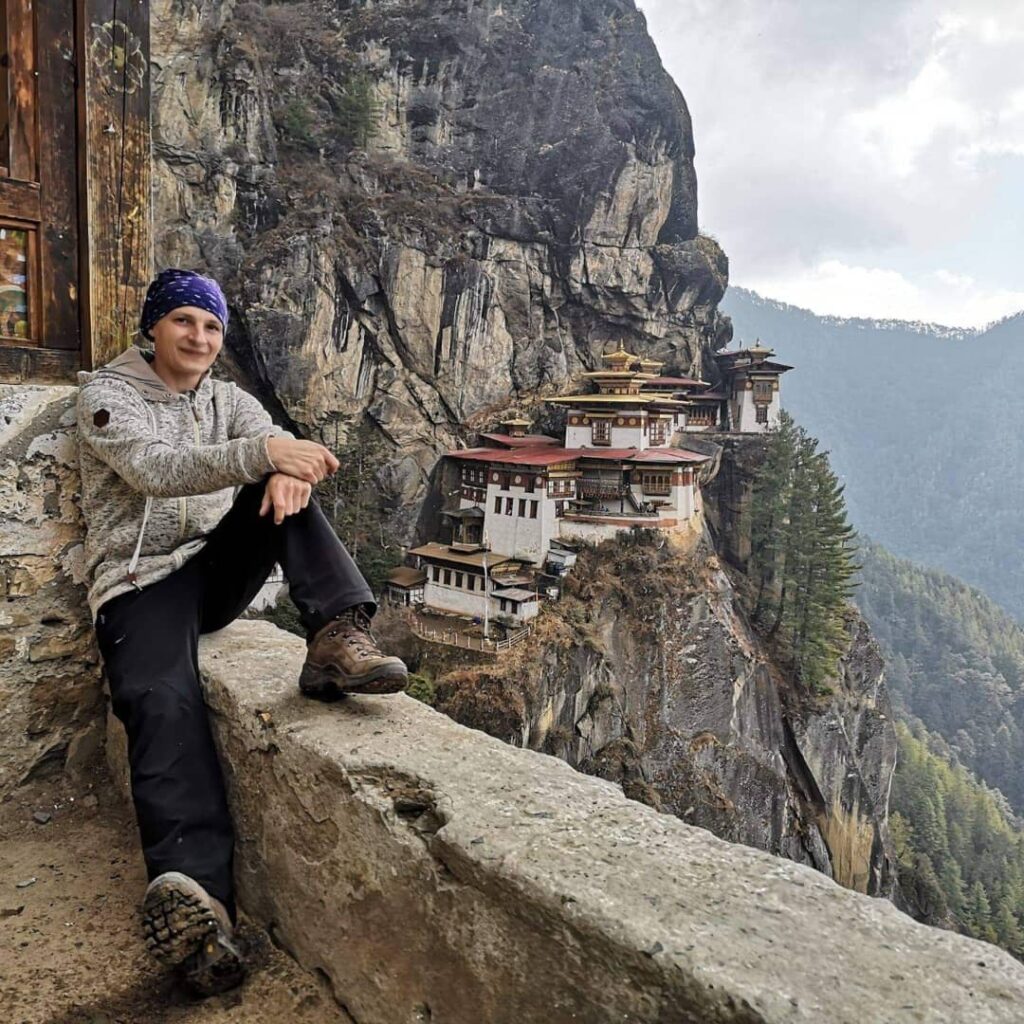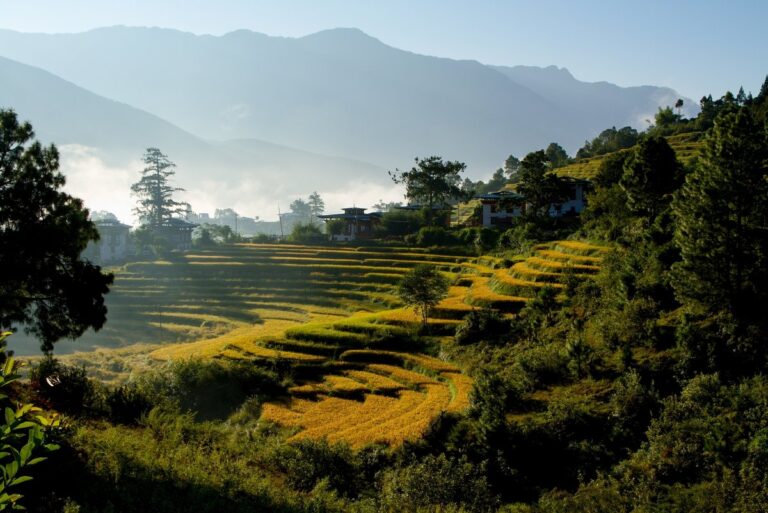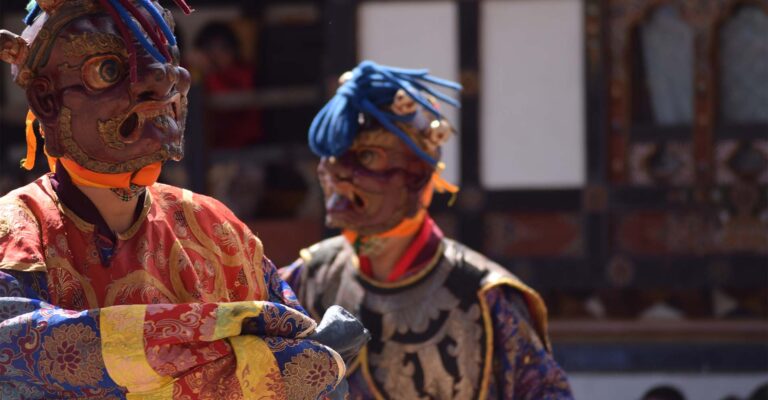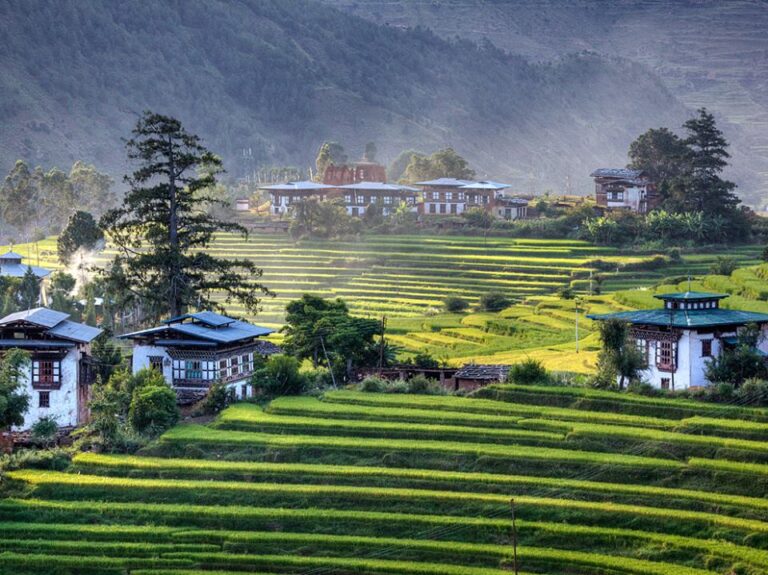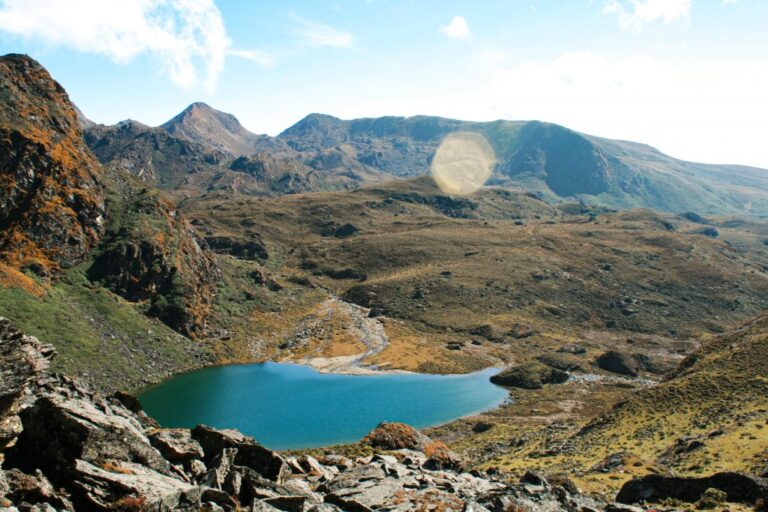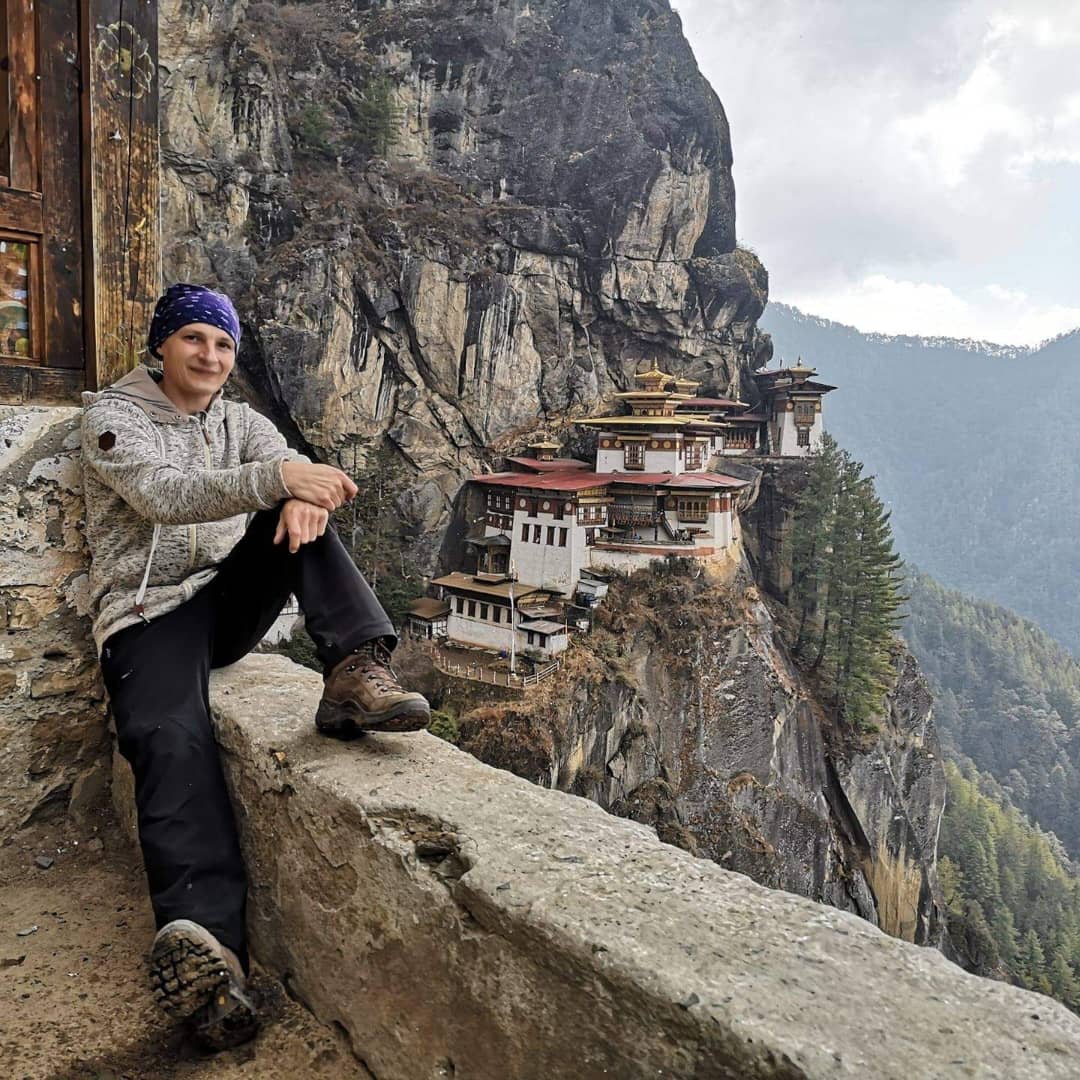

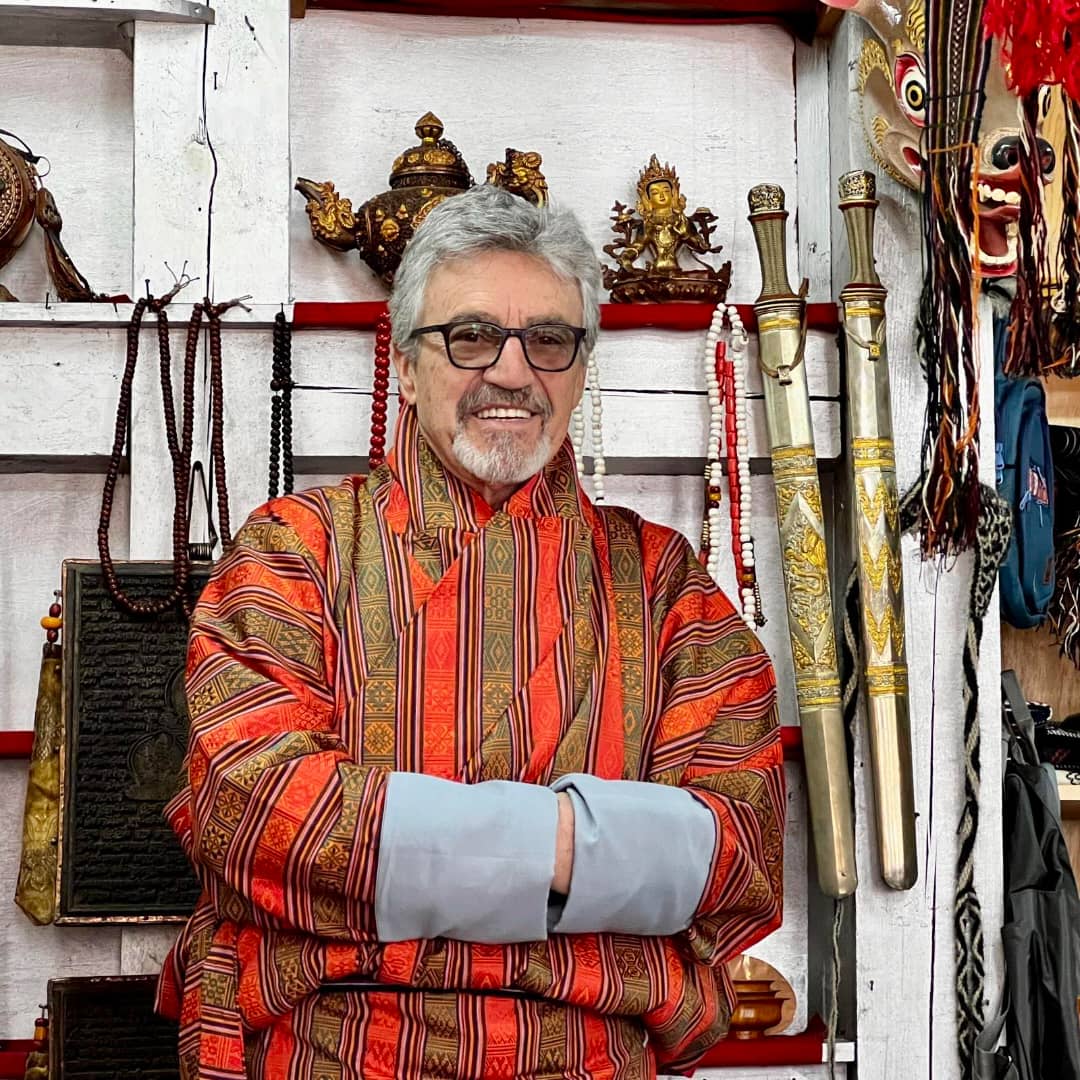
Enzo Lombardi and Susy Dan (Belluno – Italy)
Enzo Lombardi and Susy Dan (Belluno - Italy)
- HOME
- Enzo Lombardi and Susy Dan (Belluno - Italy)
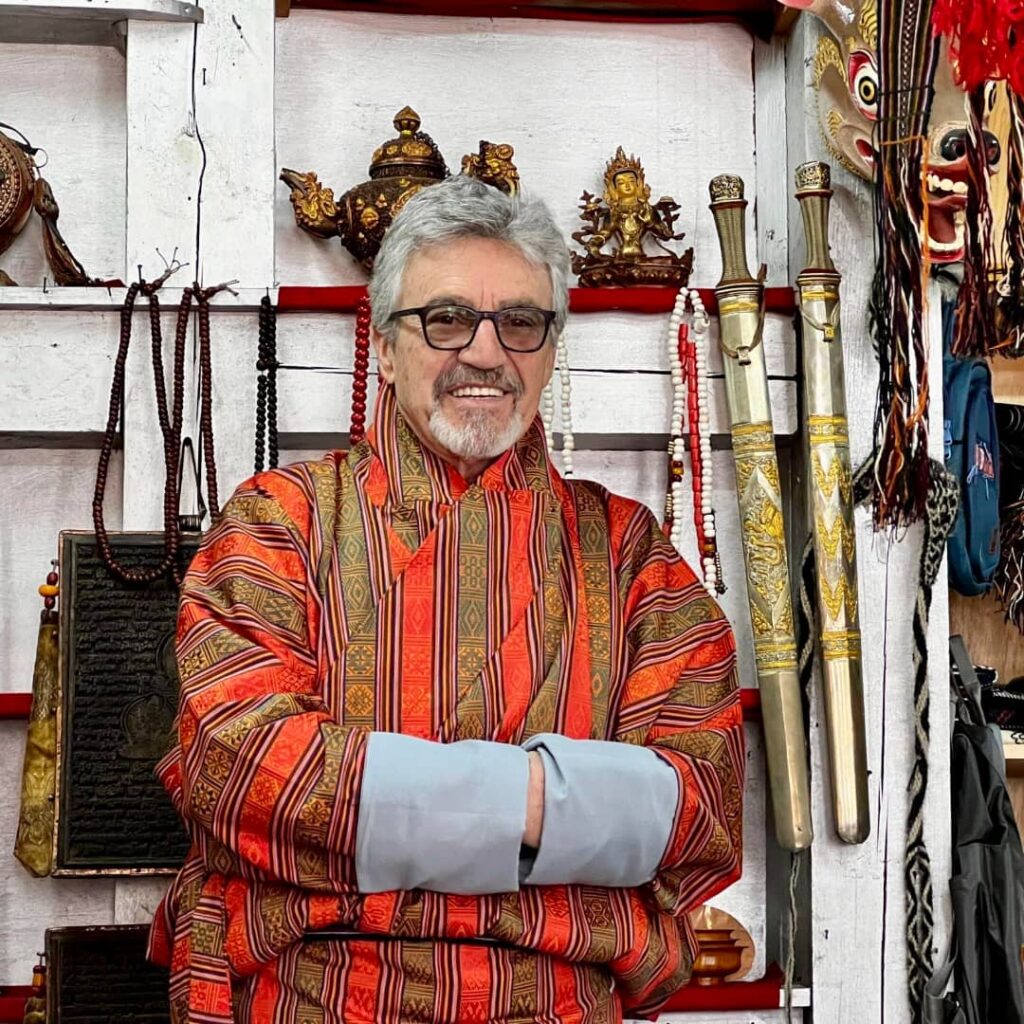
Enzo Lombardi and Susy Dan (Belluno - Italy)
“We visited the Kingdom of Bhutan in October 2018 and again April 2024 accompanied by Nima Yoezer. The first time was a real discovery of the country dedicated to the most famous and spectacular places but also to small rural villages often reached on foot through paths. Unique and unforgettable experience. The second trip was a sort of “deepening”, with numerous visits to Buddhist monasteries and schools in search of the true spirit that animates the people and the Bhutanese culture. A spiritual journey, with slow rhythms, observation, contemplation and deep meditation. Rural landscapes, contacts with monks and nuns, frugal meals in farmhouses, visits to agricultural communities, walks in the flowering forests of rhododendrons and among the rice fields in sowing. Unique experiences of great humanity that made us discover a people meek, kind, shy but empathetic, rich in culture, traditions and Buddhist art that we will keep forever in the deepest corner of our heart. Nima was a very professional and competent guide with the extraordinary ability to make you understand the deep meaning of things.”
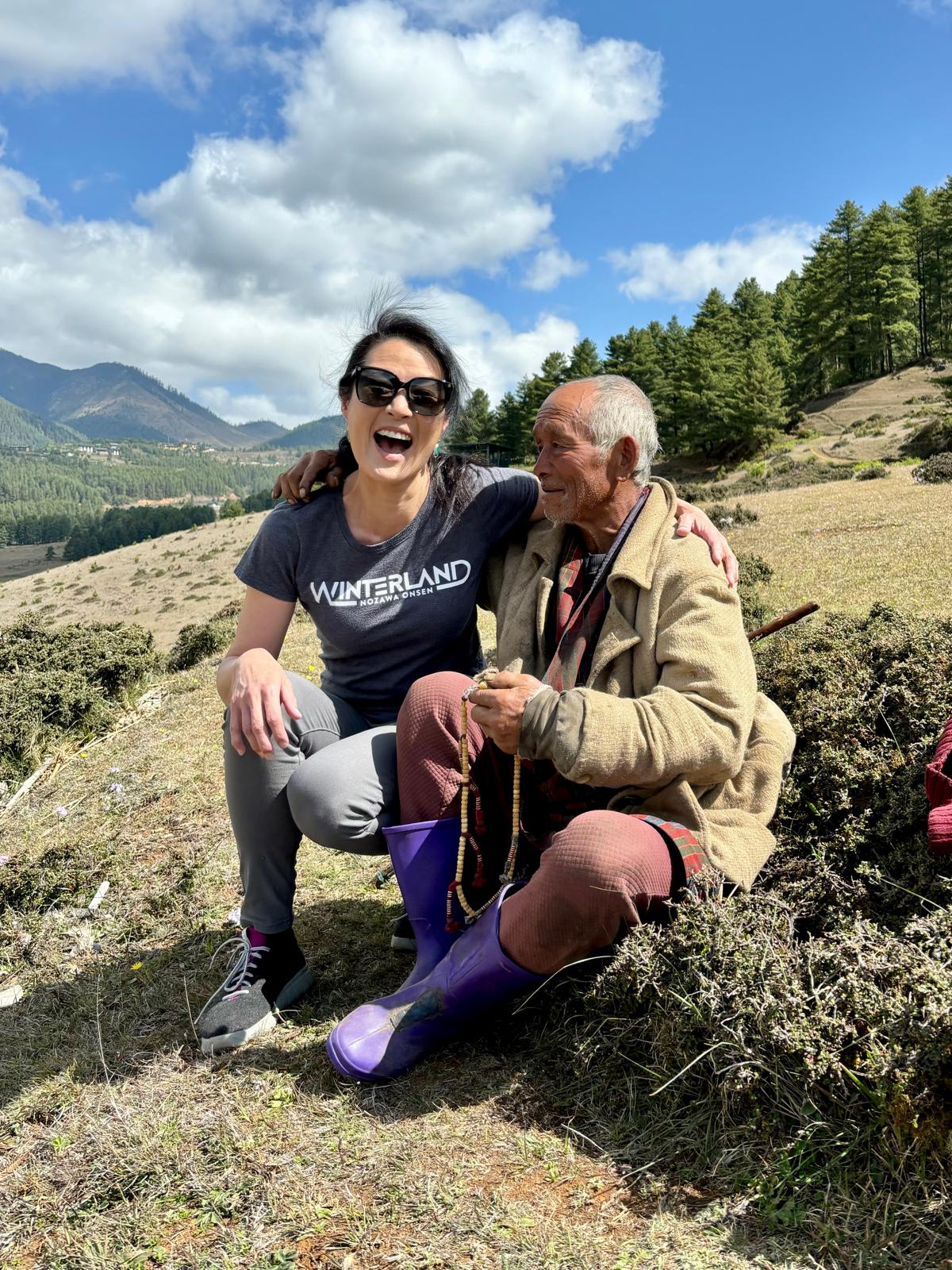
Emily Fung, Australia
Emily Fung, Australia
- HOME
- Emily Fung, Australia
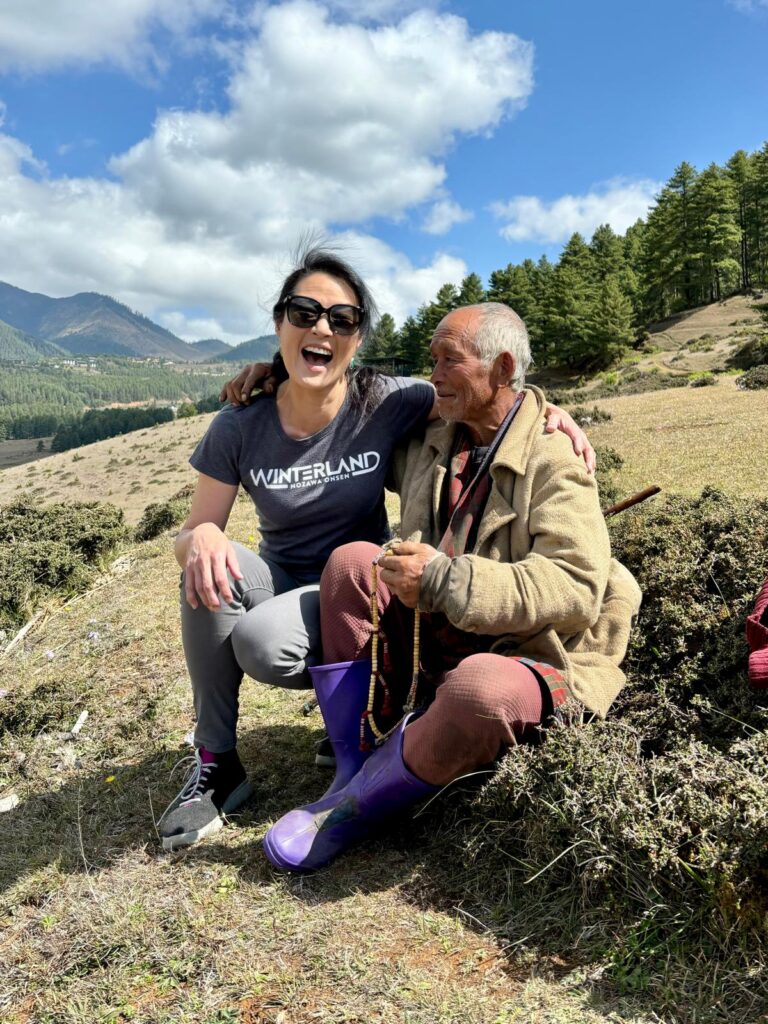
Emily Fung, Australia
“I recently had the great privilege of travelling to magical, spiritual and captivating Bhutan, “Land of the Thunder Dragon”. Nima and Pema arranged every detail of my trip with the greatest of care and kindness. Thanks to them, my time in Bhutan was absolutely unforgettable.”
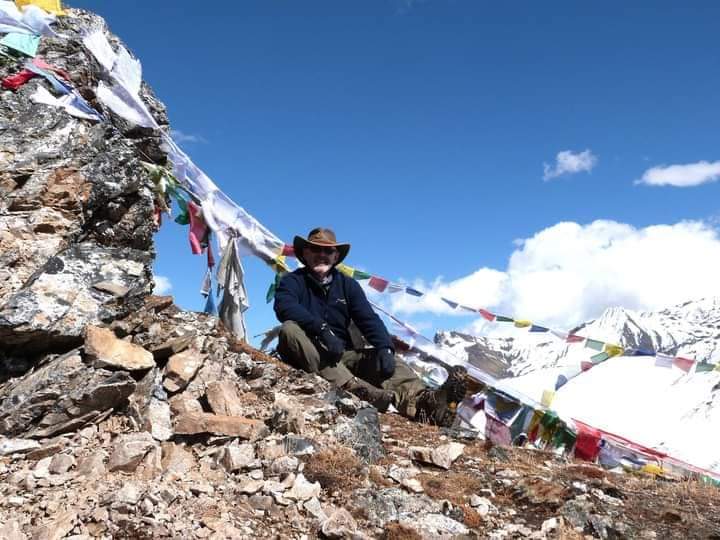
Vaughan Sydenham, UK
Vaughan Sydenham, UK
- HOME
- Vaughan Sydenham, UK
“I travelled with Nima to Chomalhari Basecamp and across the Bonte La Pass. Nima is a highly knowledgeable and engaging guide. He has a warm and welcoming personality and is always highly focussed on providing clients with the best possible experience. He is attentive and is able to very effectively convey his love and understanding of Bhutan’s wonderful geography and culture. I highly recommend his services . Vaughan Sydenham”
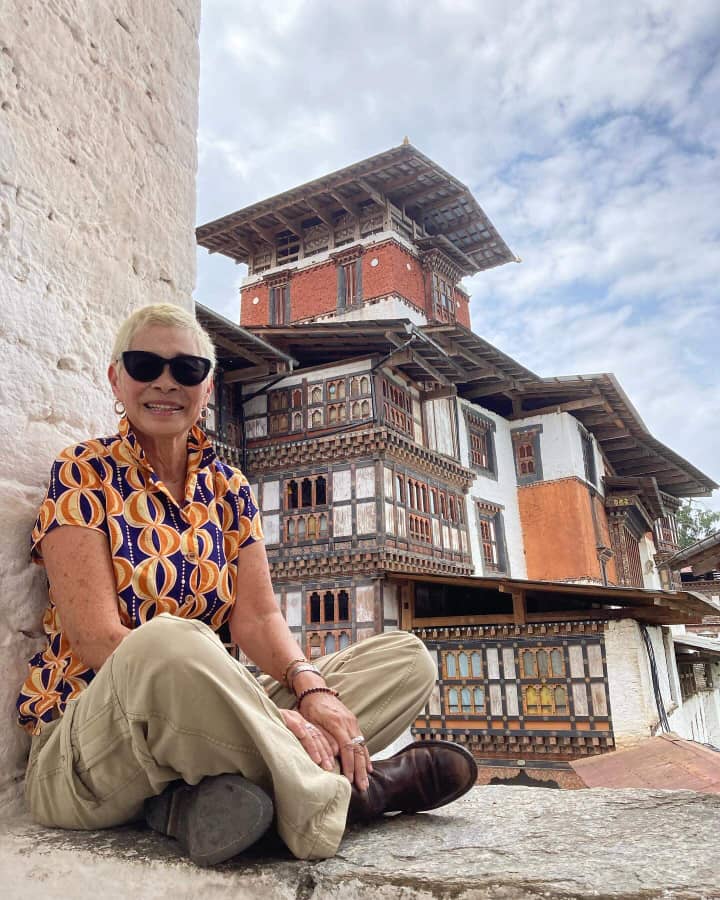
Julie Faint – Sydney, Australia
Julie Faint - Sydney, Australia
- HOME
- Julie Faint - Sydney, Australia

Julie Faint - Sydney, Australia
My recent 3 week journey through Bhutan was an incredible 2 weeks of cultural immersion and 1 week of an exhilarating trek to the Jomolhari Base Camp. May was a wonderful month to see Bhutan as its countryside was filled with rhododendrons, azaleas plus other stunning flora and the weather was pleasant during the day and the nights not too cold. Staying at a farmstay is the way to go and I would recommend Damchi Homestay with Kinley Dema as my host ( a wonderful and welcoming introduction to the Bhutanese way of life), then onto exploring the ancient fortresses and monasteries in Punakha,Tsonga, and Bumthang where the architectural beauty of these buildings is absolutely stunning to finally experiencing the 7 day trek along breathtaking mountain ridges, through river valleys, lush forests and scattered yak herder villages – until we reached the Jomolhari Base Camp site- an altitude of 4100m. A day trip, to an elevation of 4430m to view Tshophu – the Twin Lakes, above the Jomolhari Base camp is an absolute must do walk where we spotted yaks, Blue sheep and marmots and if you are lucky the elusive Snow Leopard. Also at the base campsite, its also worth exploring Jomotsang chu, a stream that flows from the glacial lake of Jomolhari. My guide, Nima Yoezer, and the support crew (Dechen,Penjou, Samdrup and Dawa) were exceptional. Combining local knowledge with genuine passion, regaling me with stories around the campfire and ensuring my safety and comfort throughout. I would highly recommend this journey to anyone seeking a transformative plus spiritual travel experience, guided by passionate freelance guides who truly and sincerely care about sharing the best of Bhutan with their guests.

Bhutan Luxury Tour
Bhutan Luxury Tour
- HOME
- Bhutan Luxury Tour
This trip provides a blend of cultural exploration, luxury car & accommodations, and scenic beauty, ensuring you experience the best of Bhutan while enjoying comfort and personalized service. The trip caters to clients seeking exclusive accommodations, personalized services, and unique cultural immersion.
These luxury experiences not only showcase Bhutan’s natural beauty and cultural richness but also provide travelers with unparalleled comfort, personalized service, and unforgettable moments in the Land of the Thunder Dragon.
- Arrive at Paro International Airport, where you’ll be greeted by your Bhutan guide
- Drive to capital city Thimphu- 1hr
- Transfer to your luxury hotel Amankora set amidst pinewoods
- Meditation session with the Buddhist master followed by Q&A session
- After breakfast, explore the capital city; Memorial stupa, Buddha Dordenma statue/option for
Kuenselphodrang hike- 2hrs easy - Explore local market and shops for handicrafts and souvenirs
- Return to your hotel for relaxation or spa treatments
- Sun Rise breakfast over Dochu La pass (3,000m) with majestic views of Bhutan’s own Himalayas
- Continue drive to Punakha- 2hrs
- Explore the magnificent Punakha Dzong (fortress) set on the confluence of two rivers
- Retreat for today in Pemako, an earthly paradise waiting to be discovered
- After breakfast embark on a scenic Jiligang Ridgeline hike (Moderate-hard, 5hrs return)
- Picnic lunch by the riverside
- Spa/Massage, enjoy a leisurely evening at your luxury hotel
- Drive Gangtey- 3hrs leisurely with stops on the way for stretch and photography.
- Visit Gangtey Monastery, evening option to attend evening prayers performed by monks in Gangtey Shedra (Buddhist College)
- Check into Gangtey lodge, offering a unique blend of luxury, adventure & spiritual retreat
- Soak into traditional hot stone bath, relax and enjoy the views of the valley below
- After breakfast enjoy nature trail hike- 1hr easy descent along the ridge of Phobjikha valley
- Attend Chod (drum ceremony) performed by nuns in Shechen Nunnery to bless you with longevity and good wishes in present life.
- Optional activities; local farmhouse visit, crane centre, Kumbu village, community school, village walks.
- After breakfast at leisure, you will drive to Paro- 6hrs.
- Hanging prayer flags over Lawala pass
- Check into the only Bhutanese owned five star Zhiwaling Heritage lodge with its marvelling art and architecture and a blend of modern amenities.
- Spa/Massage/Hot stone bath/Yoga session
- Early morning you will embark on a hike to the iconic Tiger’s Nest Monastery perched on a cliff at 3,000m- 5-6hrs return, moderate-hard level. The journey of thousand steps begin with a single step; take your pace, hold your breathe, enjoy the beauty of things you see around, behold the wonderful sight of Taktsang!
- On your way back to hotel, visit Kichu Lhakhang, one of the oldest temples in the kingdom and in the Himalayan regions.
- Spa/Massage in your hotel/relax/shopping in town
Transfer to Paro International Airport for your onward journey, filled with memories of your luxurious Bhutanese adventure. We hope you had a wonderful time in Bhutan. We look forward to staying in touch and maybe seeing you again. Tashi Delek & Bon Voyage!
Other Tour Packages

ALL BHUTAN CONNECTION
All Bhutan Connection
- HOME
- All Bhutan Connection
Fly into Paro valley. Enroute on your flight, if the weather is clear, you will be treated with the massive views of the eastern Himalayan peaks, including Kanchenjunga (28,169 ft) – World’s third highest mountain and Bhutan’s holy mountain, Jomolhari (24,000 ft). Land into the enthralling Paro International Airport – the only international airport operational in the country. There’s a time to freshen up and have lunch before heading out to Hike to Zuri Dzong (2,600m /8,600 ft).
This hike is an easy little climb of about 45 minutes above to Zuri Dzong from the National Museum. The Dzong was built by the Unifier of Bhutan Zhabdrung Rinpoche, which also served as watch tower for the Rinpung Dzong down below. The trail lines along the pine woods with the views of the Paro Dzong, the Paro valley and the Airport. This beautiful hike will serve as an acclimatization and adaptation to the terrains of beautiful Bhutan.
Walking distance: 2.5km Walking hours: 1-2hrs Elevation gain: 80m Elevation loss: 200m
In the evening your Bhutan guide will run through the trip programs and attend to any inquires in this regard.
Overnight: Mandala Resort / Equivalent
Today you will fly out to the only remote Yonphula Domestic Airport in the Eastern districts – 45 minutes flight. We’ll pass through small towns and villages giving us our first real glimpse of traditional Bhutanese life, and architecture. At the relatively low altitude of 1150m Trashigang has a mild climate and a relaxed atmosphere and an intriguing mix of people. You will drive down to your serene lodge – about an hour and half driving distance. Enroute there’s a Sherubtse College and a Buddhist University in Kanglung which we will visit if time permits and if you are interested to visit.
We will chance to encounter farming activities and fields aplenty with oranges, beans, maize, mustard, pumpkins and marijuana aplenty for the pigs to be fed, although not legal for consumption by humans. The setting is a typical vibrant thriving community dependent on farming and rural activities. The forests still remains intact and pristine and you will be submerging in the depths of rural Bhutan. The lodge is the nestled serenely in a lushly landscape. It offers a sanctuary for the senses with unparalleled panoramic views of the countryside, elegantly decorated guest rooms, an excellent restaurant serving all Bhutanese, Indian, Chinese and Continental dishes. The compound is favorable for meditation and relaxing with Yoga on your own.
Overnight: Lingkhar Lodge/Equivalent
Today morning we will drive to Radhi. The Bhutanese textiles are rich, vibrant, and colorful and are a complex art form as well as an integral part of the Bhutanese culture. We will take a chance to visit one of the private home in Radhi to see this living art passed from mother to daughter legacy in most of the eastern regions. We will then drive up to visit the Rangjung Woesel Choeling Buddhist Monastery founded in 1989. The monastery has more than 300 resident monks and old folks studying the Buddha dharma and carrying out dharma activities for the benefit of the Buddhist community. We will then have our late picnic lunch on the way back to Tashigang. Reaching Tashigang, we will visit Trashigang dzong which was built in the 17th century and has commanding view of the valley. In the past, Dzongs acted as strongholds, protecting the vale’s inhabitants in times of war against Tibetans and internal rebellions. Today, it serves as the center for administrative and monastic life and they also houses the offices of the local government and the resident monk body. The person behind the construction of such fortresses in the country is credited to Zhabdrung Rinpoche who unified Bhutan in the 17th century. Inside are few interesting temples and local government offices.
Overnight: Lingkhar Lodge/Equivalent
Today morning we will take a day excursion to the peaceful Tashi Yangtse – about 2 ½ hours driving distance sharing the border territory with Indian Tawang village. On the way we will first pay a visit to the Gom Kora temple. Buddhist scholars say that the site has been blessed with indefinite virtues and prayers: a mere visit cleanses one of sins, fulfill wishes and guides the path to Nirvana (liberation from the cycle of existence). We will then bypass the old Trashi Yangtse dzong which in the olden days used to protect former trade route with Tibet. Below the quiet town of Trashi Yangtse town is the famous Chorten Kora, the largest stupa in Bhutan built in Nepali style. This is the site of two colorful local festivals which occurs in the beginning of the year. The stupa is believed to have brought peace which otherwise was haunted by the evil spirits in days of yore. One of the amazing story about the stupa is the main relic enshrined within of that of the body of enlightened princess of Tawang who was destined to be put here. The people of Tawang still to this day comes and circumambulate the stupa and offering prayers for their princess. Trashi Yangtse is also home to National Institute for Zorig Chusum, the school where the young people learns the arts and crafts of their forefathers to keep Bhutan’s traditional arts and trade alive. In the evening we will head back to Tashigang and check into our hotel.
Overnight: Lingkhar Lodge/Equivalent
It’s about 3½ hours’ drive to Mongar but it would be a pity not to make a 2 hours detour to Dramitse Gompa, which is one of the most important monasteries of eastern Bhutan. Its name means & the peak where there is no enemy. This is the place from where the famous Naga Chham (Drums of Dramitse, included to the UNESCO list of oral and intangible heritage). The monastery was founded in 16 th century by the descendants of the saint Pema Lingpa. There is number of interesting chapels with a lot of important statues of the saints and protector deities.
If you’re in mood for short hike, you can also pursue 1.5 hours scenic hike from Dramitse to Bagingla via Shergang village. We then continue our drive to Mongar. We set off west for the first time, with our car climbing the 2,450m Kori La (a low pass by Bhutanese standards!) towards Mongar, district headquarter with its own dzong. There’ll be time to absorb the tranquility of this region, look for some of the dozens of bird species to be found here and simply relax and drink in the magic of Bhutan. During all our drives through
Bhutan we’ll be looking out for flowers and other botanical treasures and making frequent stops to admire and photograph them.
Overnight: Wangchuk Hotel/Equivalent
Today morning we will drive to Bumthang for about 8 hours. It’s a long drive but you won’t be bored, instead be thrilled to appreciate firsthand the enormous effort that went into building the highway that links western and eastern Bhutan. The climate will become more temperate as we leave the Far East and head towards central Bhutan, crossing the 3800 m (12,465ft) Thrumshing La pass. After about 141 km we’ll arrive in the wide valley of Ura, with its distinctive new Gompa (temple) and important rural high school. From here we’ll wind our way through forest and fields to Jakar, the township that lies at the center of the Bumthang district, and a favourite to all the visitors.
Bumthang is a place of special spiritual significance. Legend has it that throughout the Buddhist Himalayas there exist valleys hidden from the outside world. Sheltered and protected, together these regions could become the last bastions of traditional Tibetan Buddhism. Shangri-La in James Hilton’s Lost Horizons is based on this very idea. There remain few places more suited than Bumthang, Bhutan’s spiritual heartland, to stand as symbols of such ideals. Check into your hotel and relax.
Overnight: Rinchenling Lodge/Equivalent
Today we’ll visit one of the neighboring valleys of high and exceptionally beautiful valley of Tang. Enroute visit the Mebartsho or the Burning Lake from where Terton Pema Lingpa is believed to have uncovered sacred texts and religious objects hidden by Khandom Yeshey Tshogyal, the Tibetan consort of Guru Rinpoche. Today this site has become one of the sacred pilgrim place for the devotees around the country. Tang is the most remote of Bumthang’s valleys with not as much agriculture as the valley below, although in places where the soil is fertile and deep the Arcadian scenes are picture perfect. Terton Pema Lingpa the famous saint responsible for discovering many treasures as prophesized by Guru Rimpoche was born in this valley. The people of this valley raise sheep and at higher elevation, yaks. There is a superb Ogyencholing museum created from the former
home of the local ruling family, set high on a hill. The view and the contents of the museum are beautiful.
Afternoon, we will drive back and divert our way to Pema Choling Nunnery. The nunnery is a residential Buddhist community of 100 women and girls aged 12 – 60. Many of the women arrive at Pema Choling with little or no education, from families of farmers or road laborers or are orphans. The center offers basic education, vocational training and the opportunity to pursue traditional Buddhist studies at the highest academic level. And then we embark on the Bushman Trail Hike to Kharchu Dratshang in Chamkhar. We will
come across a village community and then walk in through the pine trees with a nice view of the valley below. The walk is a gentle climb taking us to a curve and eventually descending down – 2 ½ Hours walking distance.
Overnight: Rinchenling Lodge/Equivalent
Today morning before going out to Trongsa, we will visit Jambay Lhakhang, a fabulous temple built in the 7 th century by the Tibetan king Songtsen Gampo, on the same day Kichu Lhakhang in Paro. This temple is believed to be pinning her left knee. The temple was later visited by Guru Rinpoche and later restored by Sindhu Raja after Guru restored his life force. It has been repaired and rebuilt several times over time. It’s the one place in the valley that feels truly ancient.
Twenty minutes walking distance from the temple through fields and small Bhutanese houses, we will reach Kurjey Lhakhang. This large, active and important temple complex is named after the body imprint of Guru Rinpoche which was left in a cave when he is said to have meditated here in order to subdue the evil spirit of the valley who had sickened the local king to near- death. The advent of Buddhism in Bhutan is owed to the coming of Guru Rimpoche in the 8th century in Bumthang on the invitation by one of the minister to help cure the illness of the local king. There are 108 chortens enclosed to the complex. We will then continue to Chumey crossing the Kikila Pass (3,200 m /10,600 ft) and descend
down in the village of Zungney and check out the Yathra Factory where ladies weave Yathra, the specialty of the region. The brightly colored wool fabrics are displayed outside the houses. Quality, patterns and color vary widely. We will drive westwards through the forest of magnolias and rhododendrons and the dead dwarf bamboo plants as we ascend to Yutongla (3,425 m / 11,300 ft) on the Black Mountain range towards Trongsa – 2 Hours driving distance. Late afternoon we will visit the Ta Museum housed in the watch tower of Trongsa Dzong that has been dedicated to the kings and their legacies and some of the precious artefacts in Bhutan. Below the museum is the commanding dzong of Trongsa below with the sweeping views of Mangde Chu. We will meet some monks and interact with him and hear him share his stories.
Overnight: Yangkhil Resort
Back on the road again we’ll wind our way through forest-covered hills and past tiny villages and Chendebji Chorten, believed to be holding the evil spirit who haunted people in the days of yore in the region. Then it’s high into the rhododendron and dwarf bamboo forests of Pele La into the serenely beautiful and expansive valley of Phobjikha. This valley is famed for its winter visitors, the rare black-necked crane. Unfortunately the cranes will not be in residence when we visit but the valley is still breathtaking and there’ll be plenty of flowering plants to capture our attention. But we will take another route from Longmey village just before reaching Pelela. It is a beautiful Longtey Nature Trail Hike via Kumbu La pass (10,500 ft) – 11,700 ft and then down to Gangtey Shedra (Buddhist University)
Walking distance: 8km Walking hours: 4 – 5hrs Elevation gain: 400m Elevation loss: 545m
Head along a sloping, lined pathway that takes you through towering bushes of jade-hued bamboo, swaying together in a jumble of shadow and light. At the end of the bamboo enclave lies a small group of village houses, built in the distinct Bhutanese style, which features elevated platforms, intricately carved timber window panes and wood-lined, arched roofs. As you move upwards, you’ll pass ancient rhododendron forests and soaring trees that sigh in the wind, whispering the ancient secrets of this mystical region. The peak of the pathway features magnificent, unobstructed views of the valley and the lofty monasteries below. Next, head down to the tranquil village of Kumbu, where you can choose to end your walk, or carry on to the deep valley floor and the Shedra, a renowned and mystical place of teaching. Our car will pick us up and drive us to our hotel. Enroute check into the Crane Center to learn more about these impressive birds. Observe the beauty of the glacial valley and its communities. If you are taking a walk, you’ll encounter local students eager to practice their English. They will be happy to talk to you.
Overnight: Aum Pem Homestay/Equivalent
After breakfast at leisure, we will drive up to Gangtey Monastery sitting atop on a forested hill overlooking the green expanse of the entire Phobjikha valley. This is one of the most isolated monasteries and the largest Nyingmapa sect monastery in the country. During a visit to the Phobjikha valley, the 15 th century treasure-founder Terton Pema Lingpa prophesied that a Goemba named gang-teng (hilltop) would be built on this site and that his teachings would spread from here. Every winter to the curiosity of everyone, the revered black necked cranes are seen circling this monastery before landing in the valley and taking off for Tibet for 110 km non-stop journey.
We will then start walking from the monastery towards the long Mani stone walls (like chortens) and start our Nature Trail Hike;
Walking distance: 3.5km Walking hours: 2hrs leisurely Elevation loss: 400m
The trail hike starts from the Mani stone wall to the north of the Gangtey Gonpa and ends in Khewa Lhakhang. This hike which takes you through the pine forest and small bamboo plants secured with lichens, offering you a spectacular view of the Phobjikha Valley and the wetlands here with Black Necked cranes flocking over and around in the months of November till end of February. We will come across some rural white washed farmhouses, walk through the pine woods and then follow the ridgeline and descend down the valley. Treat yourselves with picnic lunch or just check into one of the beautiful restaurants with the nicer views of Phobjikha valley where in winter one will see these revered birds feeding on the ground. Later in the afternoon, we will visit a local farmhouse to get an insight into how Bhutanese families are living off in the far away countryside. More than 80 % of the populace are still dependent on Agriculture and rearing cattle and yaks. This would be a chance for you to interact with a Bhutanese family in a traditional Bhutanese Farmhouse and hear them share their tales of countryside and their lifestyles and about how they are coping up with the trends of modernization elsewhere. We can then walk back on the farm road back to our hotel and relax.
Overnight: Aum Pem Homestay/Equivalent
We will drive further east today to the warmer valleys of Punakha via the same Lawala Pass where we may take chance to hang our prayer flags on this sacred and scenic spot over and yell Lha Gyelo (in victory to Gods). And then going down we will take the road that takes us to Punakha – about 3 Hours driving distance. Punakha has been inextricably linked with momentous occasions in Bhutanese history. It served as the capital of the country from 1637 to 1907 and the first national assembly was hosted here in 1953. The valley hosts one of the most majestic structures in the country, the magnificient Punakha Dzong which is its masterpiece. We will reach the village of Sopsokha in Punakha where we will have lunch after which we will hike to Chimi Lhakhang which is an easy walk through fields and a clustered village homes and local souvenir shops filled with phalluses;
Walking distance: 2km return Walking hours: 2hrs return Elevation gain: 50m Elevation loss: 50m
Chimi Lhakhang was built in dedication to Drukpa Kuenley, the Divine Madman who was famed widely for his irreverent methods of teaching the dharma some 500 years ago. The whole valley is showered with traces of his influence, and villagers still enthusiastically recount the legends of his exploits. The temple is also referred to as the Temple of Fertility. Women having the problem of conceiving comes here to pray and get blessings with a wooden phallus that’s tapped on the head of the women. He is also the saint who advocated the use of phallus symbols as paintings on walls and as flying carved wooden phalluses on house tops at four corners. There are souvenir shops around with many displays of phalluses and gifts to take back home.
And drive up to Wolakha Nunnery. The Nunnery is located on a ridge overlooking Toebesa – Punakha and Wangduephodrang valleys. The main statues of the shrine here is the God of Compassion, Chenrizig bestowing endless love and compassion to sentient beings. The complex also houses a learning and meditation center for nuns where apart from religious training it provides life skill training like tailoring, embroidery, statue making and Thangka painting. We may want to talk to some of the nuns here and interacting with them and learn something from them in their pursuit of Buddhahood and nirvana.
Overnight: Happiness Field Village/Equivalent
In the morning, drive up to Habisa Bridge from where you will start your beautiful Hike to Khamsum Yulley Namgyel Chorten. The walk starts from the bridge spanning over the Mo Chhu river. The river lately has opened up for kayaking and white water rafting activity. We will walk through the fields of paddies and organic vegetable gardens and Bhutanese houses before slowly climbing up the winding path towards the stupa above.
Walking distance: 2km return Walking hours: 2hrs return Elevation gain: 200m Elevation loss: 200m
Khamsum Yulley Namgyal Chorten was built in dedication to the King, country and for the wellbeing of Bhutanese. It is a fine example of Bhutanese architecture majestically located in idyllic countryside north of Punakha. The temple is a 3 storied structure and is 30-meter (100- feet) tall with all sorts of deities imaginable inside the shrines! One can climb up all the way to the roof top of the stupa and be enthralled by the amazing views of the surrounding mountains and the Mo Chhu meandering down the valley south. We walk back the same route back where our car will pick us up and take us to an exclusive camping ground by the bank of the river for lunch. In the morning, we will visit the impressive Punakha Dzong, considered one of the most important and also one of the most beautiful Dzongs in the Kingdom. It was built by Zhabdrung Ngawang Namgyel in 1637, and was the seat of the government until Thimphu was established as the permanent capital in the 1960s. It is still the winter residence of the Dratshang (The Central Monk Body). As you move around you will admire the impressive, colorful and detailed artistry of the surroundings, including huge statues of Buddha, Guru Rinpoche and the Zhabdrung, as well as paintings of one-thousand Buddhas in one of the shrine you will visit. It’s a photographer’s haven for taking pictures in and around the dzong.
Overnight: Happiness Field Village/Equivalent
We will then drive out towards Thimphu – about 3 hours driving distance. The sub-tropical forests will give way to alpine forest as we make our way past beautiful Dochula Pass (3,000 m / 10,000 ft) marked by many prayer flags. There are 108 stupas built over the pass with an astounding panoramic views of the eastern Himalayas of Bhutan including the largest peak, Gangkar Puensum (Mountains of three sisters) at 7,564 m. Bhutanese families enjoy visiting the pass during holidays and weekends to picnic and simply enjoy the scenery. It is common to see families and groups of friends seated amongst the chortens, enjoying a packed lunch and hot tea. It is an ideal location to capture beautiful pictures of Himalayan mountain range during clear, warm days. Thimphu is the largest city in Bhutan with a population of about 1, 20,000 and the city without traffic lights! It is home to the Government, royal families and the head offices of international aid organizations. There are restaurants and disco theque abound! But the city still preserves its
traditional character in fusion with modernity. Time stands still in Bhutan and you will know why. We will then drive down visit the popular Jigme Dorji Wangchuk Memorial Stupa nestled in the heart of the city. It is one of the most visible religious structures in Thimphu designed in a Tibetan style. Today people from all walks of life flocks here in the evening to circumambulate the stupa. Older generation folks are seen chit chatting and chanting prayers and getting together around the prayer wheels in the vicinity.
We drive up to Motithang, the land of pearls above Thimphu city, and drop by the Takin Preserve to see our national animal Takin, which is endemic only to Himalayan ranges. It is a stout funny looking animal with a mythical story related to it with the Divine Madman, Lama Drukpa Kinley.
Overnight: Tara Phendeyling/Equivalent
In the morning after breakfast, drive about 15 minutes from your hotel to Kuenselphodrang where the largest sitting statue of Buddha Dordenma (169 ft. tall) is located on a hill
overlooking the Thimphu valley facing the eastern realms of the universe. The statue houses three storied shrines inside with more than 125,000 mini stupas of Buddhas. It’s a symbol of peace and harmony bestowing infinite love and compassion upon all sentient beings in the sphere). One will also have a good view of the valley of Thimphu from here. The Buddha looks best in morning light. There’s a beautiful trail that leads us inside the Kuenselphodrang Park where one can enjoy the scenic views of the valley below. The walk will take us about 45 minutes (round trip).
After breakfast at leisure, we drive up to Dodena – about 45 minutes driving distance from town. There’s a beautiful Bhutanese cantilevered bridge spanning the Wangchu (river) and bypassing the stupa, we will start walking up to Cheri Monastery.
Walking distance: 3km return Walking hours: 2hrs return Ascent: 330m Elevation loss: 330m
Cheri Monastery was established by Zhabdrung Ngawang Namgyal (The Unifier of Bhutan) in 1620. The monastery is now a major teaching and retreat center for the Drukpa Kagyud sect of Buddhism, the state religion. The Monastery serves as the monastic school for study of Buddhist Philosophy, metaphysics, mathematics, poetry and many other Buddhist studies. The serene setting and the sanctity of the place here favors one to meditate. Thus you are advised to maintain silence and respect the privacy of the hermits and the resident monks here in solitude. We walk back the same route and make it out for Picnic Lunch by the riverside. Enjoy the peacefulness of the spot with birds chirping and river gushing below. On the way back to town we will drop by in Pangri Zampa College of Astrology. It’s an educational Institute of Central Monastic body for learning traditional astrology of Bhutan. Every year, the institute releases official Bhutanese calendars. It also decides dates for important national events of Bhutan. You may want to find out your astrology if you are interested to learn! Visit Changlimithang Archery Ground where men are playing the archery, Bhutan’s national and the favourite sports. It is one of the active site where crowds cheers on the players who shoots arrows towards the distance of 160 m! It’s fun to watch them jeer onto opponent and then there’s drinking and dancing on the hits on the target. Your guide may consider to walk you out to the hotel since the traffics are busy in the evening by this time. Continue driving towards Jungshi Paper Making Factory where you can observe the entire process of producing handmade paper using ancient traditional methods that have been practiced for generations. Deh-sho paper was originally used by monasteries for woodblock and manuscript books and also for writing prayer books. The Jungshi paper factory continues to
preserve and promote this age-old Bhutanese tradition. Our hotel today will be on the outskirt of the city in Motithang serenely located in the pine woods.
Overnight: Tara Phendeyling/Equivalent
Yet another day to explore more of Thimphu. We will begin by visiting the National Institute for Indigenous Treatment. The institute collects medicinal plants from remote corners of the Bhutanese Himalaya and then distributes pills, tablets, ointments and medicinal teas to regional health-care units around the country. The small museum details some of the 300 herbs, minerals and animal parts that Bhutanese doctors have to choose from. National Institute for Zorig Chusum (Painting School) where students are taught the thirteen traditional arts and crafts. The institute operates four- to six-year courses for the students. Though large groups of visitors can disrupt the classes, the craft demonstrations are a photographers’ dream and it’s hard not to be impressed with the skill and discipline of the young students.
A few minutes’ walk will reach us to Folk Heritage Museum. It is a restored three-storied rammed-earth and timber building replicating a traditional farmhouse and is furnished as it would have been about a century ago to provide an interesting glimpse into rural Bhutanese life. Also the place has an open place for the children to have time on their own. There’s a restaurant here that provides delicious Bhutanese cuisines to the visitors. Enjoy your lunch. Royal Textile Academy which showcases the art of weaving and the country’s rich textile heritage and traditional design. You can see the royal robes, watch the video on wearing the Gho and kira, traditional Bhutanese attires. You can also view jewelry, kettles, crowns, and armory donated by the royal family. Just below the museum you will observe weavers working on their pattern. Some of them are young teenager girls learning the trade from the mothers and ancestors and keeping the trade alive. Just above the museum, we can walk across a long stretch of Craft Bazaar stalls to go through
its handicrafts and souvenirs. This is one of the initiative to empower women in self-sufficiency by creating their own arts and crafts and selling it for income. At the end of the Craft bazaar, is yet another Handicrafts emporium runned as NGO by women. Free time / relax in your hotel. For those of us who are interested to walk back to the hotel, you may discuss with your guide and he will coordinate it with you.
Overnight: Tara Phendeyling/Equivalent
It will take us about an hour and half to drive to reach to Paro, one of the spectacular places in Bhutan. The winding road through one of the best highways in the Kingdom following the course of Wangchu till the Chuzomsa and taking right turn, following the course of Pa Chhu which flows from Mount Jomolhari, the second largest peak in Bhutan. Enroute stop by to marvel at the beautiful Tachog Lhakhang dating back to 14th century for photography. Below the temple is the iron-chained bridge built by Thangthong Gyalpo, the iron chain bridge builder and the one to whom the temple above is attributed to. Upon reaching Paro, visit the National Museum of Bhutan with excellent displays of all facets
of the country’s rich cultural history; old costumes and battle dress, together with priceless jewelry and specimens of the kingdom’s unique flora and fauna are included within the
museum. And then drive down to visit the fortress on the heap of jewels, Paro Rinpung Dzong. The Dzongs’ structure is vast and full of colors with monks strolling around and always up for cheerful greetings and photography. Talk to some of the monks you will meet here and know their life stories as an ordained monk. A few scenes from Bernardo Bertolucci’s Little Buddha (1995) were filmed here. Below the dzong, a traditional wooden- cantilevered bridge spans the Paro Chhu. Drive up to the only Bhutanese owned five star Zhiwaling Heritage away from the hustle and bustle of the town. The hotel won the Unique Lodge Accolade from National Geographic few years back. Enjoy your stay and hospitality.
Overnight: Janka Resort/Equivalent
Early in the morning we will drive to Paro – an hour and half driving distance till the base of Tiger’s nest monastery. And then drive for about 35 minutes from here to the base of the Tiger’s Nest Temple.
Walking distance: 8.5km return Walking hours: 5 – 6hrs return Elevation gain: 600m Elevation loss: 700m
Guru Rinpoche visited and sanctified Bhutan in the 8th century when evil spirits abounded and harmed people. Legend has it that Guru Rinpoche flew to this site on a tigress’ back to subdue a local demon residing here. Thereafter, he is believed to have meditated here for four months and introduced Buddhism in the valley. Taktsang is Bhutan’s most sacred site, hanging on a cliff on a sheer height above beautiful forest of blue pine and rhododendrons at 10,000 ft. One have the option of making it till the mid-way (an hour and half) where there’s a cafeteria and an amazing sight of the temple in the front. Or else we can still push up for about another 45 minutes to the view point up where you will feel the temple just close by at your height. We can then continue climbing stone steps down until we reach a ravine with a waterfall and then begin our final steps up to the temple for one last ascent. We walk back the same trail and have our lunch in the cafeteria. It’s a full day program for today for the hike so there’s no need to rush but take your pace and enjoy the hike and the scenery. In the evening we visit Kichu Lhakhang, one of the oldest temples in Bhutan. Legend says that a giant demoness lay across the whole area of Tibet and the Himalayas and was obstructing the spread of Buddhism. So in order to control her, King Songtsen Gampo of Tibet is believed to have built 108 temples which are placed on all points of her body. Kichu Lhakhang was one of the 108 monasteries (pinning her left sole of the feet). We have the opportunity to light butter lamps and offer our prayers for ourselves and for people we love and to all sentient beings.
Continue drive to Paro town. The main street, only built in 1985, is lined with colorfully painted wooden shop fronts and restaurants and handicrafts for souvenirs. Paro remains one of the best Bhutanese towns to explore on foot and is worth an hour or two’s stroll at the end of a day of sightseeing. Free time and souvenir
Overnight: Janka Resort/Equivalent
Today morning, you will depart from Bhutan. Our representatives will check you into the airport and bid their farewells there. We hope you had a nice time in Bhutan.
TASHI DELEK & BON VOYAGE
Other Tour Packages

THIMPHU TSHECHU
Thimphu Tshechu
- HOME
- Thimphu Tshechu
Fly into Paro valley. Enroute on your flight, if the weather is clear, you will be treated with the massive views of the eastern Himalayan peaks, including Kanchenjunga (28,169 ft) – World’s third highest mountain and Bhutan’s holy mountain, Jomolhari (24,000 ft). Land into the enthralling Paro International Airport – the only international airport operational in the country. There’s a time to freshen up and have lunch before setting out to explore the Paro town. We will start off with the visit to the National Museum of Bhutan with excellent displays of all facets of the country’s rich cultural history; old costumes and battle dress, together with priceless jewelry and specimens of the kingdom’s unique flora and fauna are included within the museum. The winding road that leads up to the museum offers a good view of the Paro valley below. And then drive down to visit the fortress on the heap of jewels, Paro Rinpung Dzong. The Dzongs’ structure is vast and full of colors with monks strolling around and always up for cheerful greetings and photography. Talk to some of the monks you will meet here and know their life stories as an ordained monk. A few scenes from Bernardo Bertolucci’s Little Buddha (1995) were filmed here. In the past, Dzongs acted as strongholds, protecting the vale’s inhabitants in times of war against Tibetans and internal rebellions. Today, it serves as the center for administrative and monastic life and they also houses the offices of the local government and the resident monk body. Below the dzong, a traditional wooden- cantilevered bridge spans the Paro Chhu. Our car will pick us up and check us into the hotel. Trip Orientation by your Bhutan Trip leader over dinner.
Overnight: Janka Resort/Equivalent
Today you will take a flight to Bumthang from Paro International Airport – 35 minutes flight. Legend has it that throughout the Buddhist Himalayas there exist valleys hidden from the outside world. Sheltered and protected, together these regions could become the last bastions of traditional Tibetan Buddhism. Shangri-La in James Hilton’s Lost Horizons is based on this very idea. There remain few places more suited than Bumthang, Bhutan’s spiritual heartland, to stand as symbols of such ideals.
Jambay Lhakhang from where you will start the sightseeing on hike. Jambay Lhakhang is a fabulous temple built in the 7 th century by the Tibetan king Songtsen Gampo, on the same dayKichu Lhakhang in Paro. This temple is believed to be pinning her left knee. The temple was later visited by Guru Rinpoche and later restored by Sindhu Raja after Guru restored his life force. It has been repaired and rebuilt several times over time. It’s the one place in the valley that feels truly ancient Twenty minutes walking distance from the temple you will reach Kurjey Lhakhang. This large, active and important temple complex is named after the body imprint of Guru Rinpoche was left in a cave when he is said to have meditated here in order to subdue the evil spirit of the valley who had sickened the local king to near-death. There are 108 chortens enclosed to the complex Further you cross over a suspension bridge spanning over the Chamkhar Chu you make it to Tamshing Lhakhang This Goemba (Temple of the Good Message) was established in 1501 by Terton Pema Lingpa and is the most important Nyingmapa Goemba in the kingdom. Pema Lingpa built the unusual structure himself, with the help of khandromas (dakinis), who are believed to have made sculpted many of the statues inside. On the inner walls are what are believed to be original unrestored images that were painted by Pema Lingpa, though there are even older paintings underneath. The temple is a heritage site today. Finally end your day with the visit to the Swiss Farm, Bhutan’s only commercial cheese factory.
Explore inside and free cheese tasting. Also try tasting the Panda beer produced by the Swiss Brewery!
Overnight: Yugharling Resort/Equivalent
Tang is the most remote of Bumthang’s valleys with not as much agriculture as the valley below, although in places where the soil is fertile and deep the Arcadian scenes are picture perfect. Terton Pema Lingpa the famous saint responsible for discovering many treasures as prophesized by Guru Rimpoche was born in this valley. The people of this valley raise sheep and at higher elevation, yaks. Enroute visit the Mebartsho or the Burning Lake from where Terton Pema Lingpa is believed to have uncovered sacred texts and religious objects hidden by Khandom Yeshey Tshogyal, the Tibetan consort of Guru Rinpoche. Today this site has become one of the sacred pilgrim place for the devotees around the country. Ogyencholing Museum in Tang valley was restored in the 19 th century. Today it houses the Family Museum, a place that will transport visitors to another world and time. The visitors will view permanent exhibits recreated to capture the ambience of the lifestyle of the Trongsa Penlop (Governor) Tshokye Dorji and his household. It also serves as retreat for those engaged in religious history. Bhutan’s history truly unfolds here. We will drive back to Pema Choling Nunnery after lunch. The nunnery is a residential Buddhist community of 100 women and girls aged 12 – 60. Many of the women arrive at Pema Choling with little or no education, from families of farmers or road laborers. The center offers basic education, vocational training and the opportunity to pursue traditional Buddhist studies at the highest academic level. From here we will embark on the Bushman Trail Hike to Kharchu Dratshang in Chamkhar – 2 Hours beautiful hike through pine trees
Overnight: Yugharling Resort/Equivalent
Today morning we will drive to Kikila (3,300 m) from where we will begin our hike to Tharpaling Monastery. We will climb straight up the mountain for about 3 hours (depending on the pace of the group), through many vegetation zones, including rhododendron and dwarf bamboo and join the royal trail used by past kings. Eventually we will be walking along the ridge of the mountains and after two hours reach the ridge covered with prayer flags straight up above the monastery. The views from the top is amazing and breathtaking and you will feel the worth of hiking today. There’s a stupa of Longchen Rabjampa we will come across and then begin descending down to Tharpaling Monastery.
The principle part of the monastery was established by Longchenpa or Lonchen Rabjam (1308- 1363) amidst his self-oust from Tibet for a long time. Longchen Rabjampa was a noteworthy educator in the Nyingmapa school of Tibetan Buddhism. His significant work Seven Treasures, epitomizes the past 600 years of Buddhist idea in Tibet. Longchenpa was a basic connection in the transmission of the Dzogchen lessons. He was abbot of Samye, one of Tibet’s most essential cloisters and the primary Buddhist religious community built up in the Himalaya, yet spent the greater part of his life journeying.
Overnight: Chumey Nature Resort/Equivalent
This morning you will drive up to Kikila Pass (23,200 m /10,600 ft) and onwards up through rhododendrons and bamboo forests over Yutongla (3,425 m / 11,300 ft) on the Black Mountain range towards Trongsa – 2 ½ Hours driving distance. Trongsa is the ancestral home of Bhutan’s ruling dynasty. Afternoon visit the Ta Museum housing a collection of historical artifacts of the Royal Family.
Drive further westward bypassing the beautiful Chendebji Chorten below the highway and climbing up to Pelela (3,390 m / 11,200 ft) and reaching Lawala Pass (3,200 ft 10,600 ft) you may stop to enjoy the beautiful sight of Mt Jomolhari (second largest peak in Bhutan) in the distant and hanging your prayer flags. Descend down to Gangtey or popularly known as the crane valley. Gangtey is a wide and beautiful valley the open grassland and thickets of dwarf bamboo, designated as conservation zone within the Jigme Singye Wangchuk National. It is a natural habitat for wildlife, including nesting grounds for endangered black-necked cranes that migrate from Central Asia in the winter (late October and stay till March). Farmlands occupy the peripheral slopes where potatoes and turnips are grown. The general vegetation is composed of mainly blue pine, birch, maple and several species of rhododendrons. Consider visiting the Crane Center before checking into your hotel. The Center has informative displays about the black-necked cranes and the valley environment. You can use the centers’ powerful spotting scopes and check what you see against its pamphlet Field Guide to Crane Behavior in the valley (November – mid March)
Overnight: Aum Pem Home/Equivalent
After breakfast at leisure, drive up to visit the Gangtey Monastery on a forested hill overlooking the green expanse of the entire Phobjikha valley. During a visit to the Phobjikha valley, the 15 th century treasure-founder Terton Pema Lingpa prophesied that a Goemba named gang-teng (hilltop) would be built on this site and that his teachings would spread from here. The significance of this monastery is the circling of the monastery by black neck cranes before landing in the valley and taking off for Tibet in February end for 110 km non-stop journey. Start the Nature Trail Hike from Gangtey monastery.
Walking Distance: 3.5 km walking Hours: 2 Hours leisurely
Elevation loss: 400 m
The trail hike starts from the Mani (like Chortens) stone wall to the north of the Gangtey Gonpa and ends in Khewa Lhakhang. This hike which takes you through the pine forest and small bamboo plants secured with lichens, offering you a spectacular view of the Phobjikha Valley and the wetlands here with Black Necked cranes flocking over and around in the months of November till end of February. Enjoy your lunch in an open space and taking in the views of wide open valley. After lunch we will continue our walk towards the south of the valley which is serene and nice time for photography. There’s a clustered village in Kingathang and you may like to take chances to meet villagers there and interacting with them. There’s also an option to do mountain biking here as there’s lesser traffic and the sceneries are amazing. Or you can check into the hotel and relax.
Overnight: Aum Pem Home/Equivalent
Drive to Punakha – about 3 Hours driving distance. Punakha has been inextricably linked with momentous occasions in Bhutanese history. It served as the capital of the country from 1637 to 1907 and the first national assembly was hosted here in 1953. The valley hosts one of the most majestic structures in the country, the Punakha Dzong. The sub-tropical environment allows cultivation of rice and numerous fruits such as oranges, mangoes and bananas, to name a few. Reaching Punakha and after Lunch, Hike to Chimi Lhakhang; Walking Distance: 2 km Round Trip Walking Hours: 2 Hours Round trip Ascent: 15 m
Chimi Lhakhang was built in dedication to Drukpa Kuenley, the Divine Madman who was famed widely for his irreverent methods of teaching the dharma some 500 years ago. The whole valley is showered with traces of his influence, and villagers still enthusiastically recount the legends of his exploits. The temple is also referred to as the Temple of Fertility. Women having the problem of conceiving comes here to pray and get blessings with a wooden phallus that’s tapped on the head of the women. He is also the saint who advocated the use of phallus symbols as paintings on walls and as flying carved wooden phalluses on house tops at four corners. There are souvenir shops around with many displays of phalluses and gifts to take back home. We will then head out to Khuruthang where we will have lunch and then drive further north to visit the impressive Punakha Dzong, considered one of the most important and also one of the most beautiful Dzongs in the Kingdom. It was built by Zhabdrung Ngawang Namgyel in 1637, and was the seat of the government every winter until Thimphu was established as the permanent capital in the 1960s. It is still the winter residence of the Dratshang (The Central Monk Body. As you move around you will admire the impressive, colorful and detailed artistry of the surroundings, including huge statues of Buddha, Guru Rinpoche and the Zhabdrung, as
well as paintings of one-thousand Buddhas in one of the shrine you will visit. If time permits you may want to walk on over the longest suspension bridge, ten minutes’ walk
away from the fortress in the back over Pho Chu. The valley’s rivers have also opened up for rafting and kayaking activity.
Overnight: Happiness Field Village/Equivalent
Today you will drive to Thimphu – 2 ½ Hours driving distance via the beautiful Dochula Pass (3,000 m / 10,000 ft). There are 108 stupas built over the pass with an astounding panoramic views of the eastern Himalayas of Bhutan including the largest peak, Gangkar Puensum (Mountains of three sisters) at 7,564 m. Bhutanese families enjoy visiting the pass during holidays and weekends to picnic and simply enjoy the scenery. It is common to see families and groups of friends seated amongst the chortens, enjoying a packed lunch and hot tea. It is an ideal location to capture beautiful pictures of Himalayan mountain range during clear, warm days. Thimphu is the largest city in Bhutan with a population of about 1, 20,000 and the city without traffic lights! It is home to the Government, royal family, and the head offices of international aid organizations. Thimphu is a mix of Himalayan and western sensibilities – internet cafes and disco theque abound! Today is a big event and thousands of people from all over the country has come to the city to witness the Grand Tshechu. After lunch in town, we will head out to the magnificient Tashichho Dzong to witness the Annual Thimphu Tshechu. No single event captures the prevailing Bhutanese culture better than the Buddhist festival. The best known are the Tsechus, occasions honoring the significant accomplishments of Guru Rinpoche, the 8 th Century figure widely revered across the Himalayas as the Second Buddha. Their focal point is a series of prayers and dances inspired by certain religious themes. Dancers in spectacular costumes perform tightly choreographed moves to a cacophony of drums, horns and cymbals. Constant chanting drifts in waves, a solemn base rising to vivid peaks.
What makes such occasions particularly remarkable is the manner in which performance merges with the overall setting. The larger festivals take place in the shadows of imposing
fortress-monasteries, attracting large crowds from the surrounding region. For Bhutanese, they represent both the opportunity to concentrate on their religion and as major social occasions. People appear in their finery, eating, drinking and making merry. The overall atmosphere is a rarified blend of devotion, conviviality and slight bawdiness. On show is the holistic, integrated and down-to-earth nature of unaffected popular Himalayan Buddhist culture. Enjoy Tshechu and dive yourself into the air of community vitality and observing the lively and vibrant festival.
Overnight: Taraphendeyling/Equivalent
Early in the morning, we will take opportunity to make it to the unfurling of the Thongdrel (Liberation at sight) ceremony to have the glimpse of this masterpiece hanging from the rooftop and dangling down to the ground to bless everyone who’s present there. There will be huge crowds so our assistant guide will have space reserved for us earlier. We will have snacks and light lunch packed and brought along with us for the Tshechu. Enjoy the last day of Thimphu Tshechu. In the afternoon we will leave the festival ground for afternoon Thimphu sightseeing. But for those who want to stay back, they can still continue on with the Tshechu. We will drive up to see the tallest sitting statue of Buddha Dordenma (52 m / 169 ft). The statue fulfills an ancient prophecy dating back to the 8 th century A.D that was discovered by Terton Pema Lingpa (Religious Treasure Discoverer) and is said to emanate an aura of peace and happiness to the entire world. The massive three-storey base houses a large chapel, while the body itself is filled with 125,000 smaller statues of Buddha. Visit Jungshi Paper Making Factory where you can observe the entire process of producing handmade paper using ancient traditional methods that have been practiced for generations. Deh-sho paper was originally used by monasteries for woodblock and manuscript books and also for writing prayer books. The Jungshi paper factory continues to preserve and promote this age-old Bhutanese tradition. We will then want to stroll in the downtown although there will be thousands of people with many cramped and tented temporary sheds selling stuffs on discount for the public.
Overnight: Tara Phendeyling/Equivalent
Early in the morning we will drive to Paro – an hour and half driving distance till the base of Tiger’s nest monastery. And then drive for about 35 minutes from here to the base of the Tiger’s Nest Monastery. Guru Rinpoche visited and sanctified Bhutan in the 8th century when evil spirits abounded and harmed people. Legend has it that Guru Rinpoche flew to this site on a tigress’ back to subdue a local demon residing here. Thereafter, he is believed to have meditated here for four months and introduced Buddhism in the valley.
Walking Distance: 8.5km Return Walking Hours: 5-6hrs Return Ascent: 600m
Taktsang Goemba or Tiger’s Nest Monastery was blessed and sanctified as one of Bhutan’s most sacred religious sites. It hangs on a cliff and stands above a beautiful forest of blue pine and rhododendrons at 10,000 ft. Today Paro Taktsang is the most sacred site for pilgrimage for Buddhists around the world and a special hiking site to conquest. We will have lunch in the cafeteria in the midway coming back or if we can make it, we will go Paro downtown for a sumptuous meal. Late afternoon, we will visit Kichu Lhakhang, one of the oldest temples in Bhutan. Legend says that a giant demoness lay across the whole area of Tibet and the Himalayas and was obstructing the spread of Buddhism. So in order to control her, King Songtsen Gampo of Tibet is believed to have built 108 temples which are placed on all points of her body. Kichu Lhakhang was one of the 108 monasteries (pinning her left sole of the feet). We have the opportunity to light butter lamps and offer our prayers for ourselves and for people we love and to all sentient beings. We will check into the hotel and refresh ourselves. Later in the late evening, we will drive to Paro town. The main street, only built in 1985, is lined with colorfully painted wooden shop fronts and restaurants and handicrafts for souvenirs. Paro remains one of the best Bhutanese towns to explore on foot and is worth an hour or two & stroll at the end of a day of sightseeing.
Free time and souvenir
Overnight: Janka Resort/Equivalent
Your guide and driver will drop you to the Airport and see you off. We hope you had a good time with us. We hope to keep in touch and do hope to see you again.
Tashi Delek & Bon Voyage
Other Tour Packages
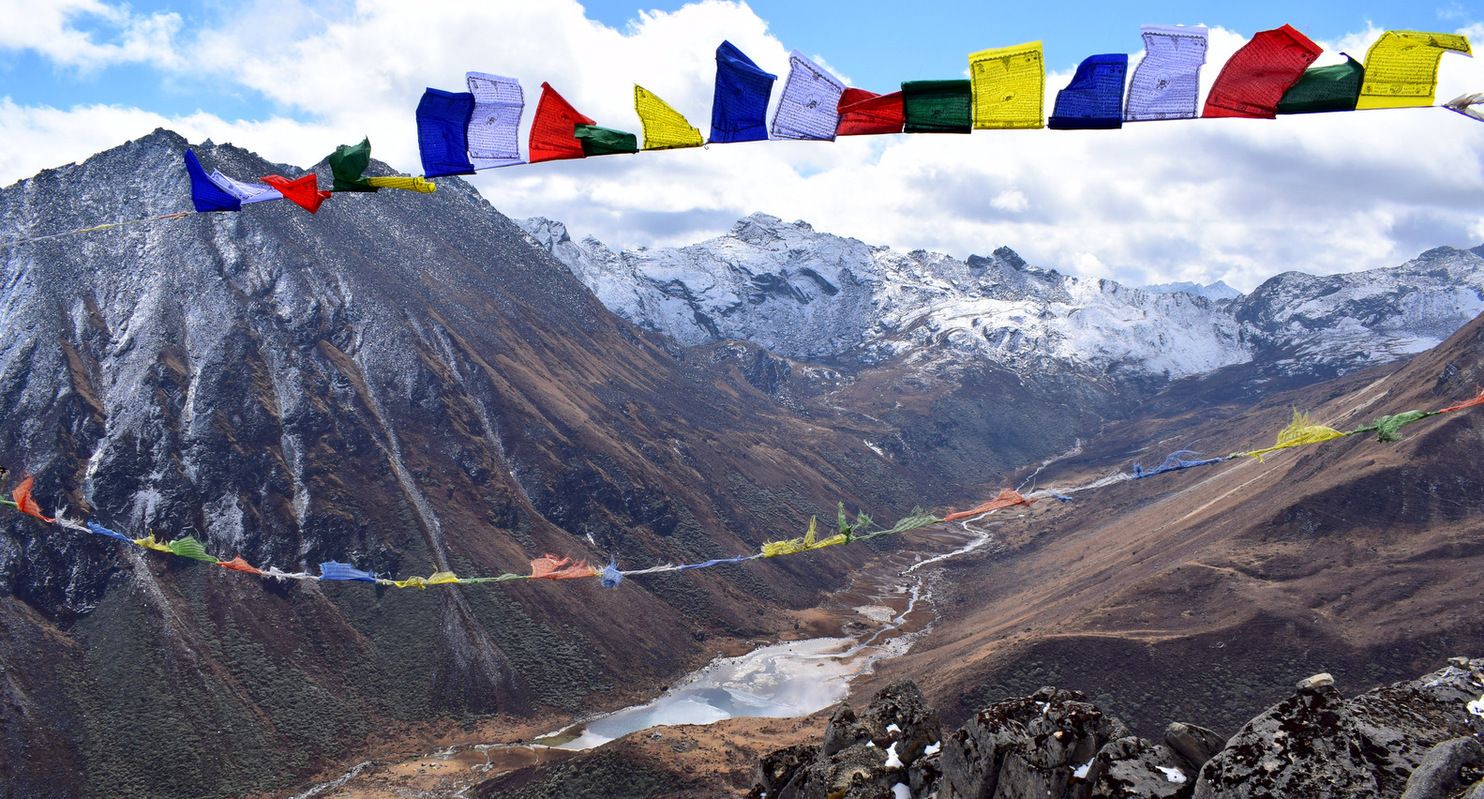
JOMOLHARI TREK
Jomolhari Trek
- HOME
- Jomolhari Trek
Fly to Paro, a historic town located in western Bhutan with tiny streets and brightly painted wooden shops. If skies are clear en route, we’ll be treated to views of the massive eastern Himalaya peaks, including Kanchenjunga, which at 28,169 feet is the world’s third-highest mountain, and 24,035-foot Chomolhari, Bhutan’s second largest and the holiest mountain. Once on the ground, you meet your Bhutanese guide and driver, who will greet you with a traditional welcome ceremony. Afternoon visit the National Museum of Bhutan with excellent displays of all facets of the country’s rich cultural history; old costumes and battle dress, thangkas and festive masks, ancient artifacts etc., A few minutes’ drive down is the Paro Rimpung Dzong. In the past, Dzongs acted as strongholds, protecting the vale’s inhabitants in times of war against Tibetans and internal rebellions. Today, it serves as the center for administrative and monastic life and they also houses the offices of the local government and the resident monk body. A few scenes from Bernardo Bertolucci’s Little Buddha (1995) was filmed here. Additionally, the University of Texas in Elpaso in USA is modelled after this Dzong’s architecture and there are few Bhutanese
studying there on scholarships. In the evening your guide will take you through a brief trip orientation and clarify if you have any queries.
Overnight: Janka Resort
Walking distance: 11 km Walking hours: 03 hours Ascent: 300 m/990 ft
In the morning drive past the Drugyel Dzong originally built as a defensive fortress to guard the
valley against Tibetan invasions in the past. We gain our first views of the summit of Jomolhari
(7,314m). On this scenic drive we pass through countryside made up of fields of rice, wheat, mustard, potato, and radish as well as herds of cows. Your car will drop you till Gunitsawa where there’s an army outpost. The feeder road ends at Shana Zam (bridge). Initially the trail is wide and flat as it meanders steadily through lightly forested fields, which in recent years have been the site of the ongoing large-scale Bhutan Government project to bring electricity to the isolated villages further up the valley. It is a reasonable day’s walk today till our campsite by a shallow meadow.
Overnight: Shingkharab campsite
Walking distance: 13 km Walking hours: 5- 6 hours Elevation gain: 770m/2540 ft
Elevation loss: 50m/165 ft
We now trek within Jigme Dorji National Park, the largest protected area in the country (4350 sq. km). The forests are tall and thick, comprising a variety of oaks, maples, birches, larches, pines, alders many varieties of rhododendrons. Many of the camps we stop at are not settlements as might be implied by them having a place name. Most are merely clearings beside a water source, which are also suitable camping sites for seasonal yak herders. From our campsite in one of the meadows we will get to see the closer view of the summit of Mt. Jomolhari.
Overnight: Thangthangkha campsite
Walking distance: 19 km Walking hours: 6-7 hours Elevation gain: ascent: 480 m/1584 ft
Continue higher to the camp at the base of the Jomolhari, a superb alpine setting. Jichu Drake (6794m) rises to our right, with a fine, elegant ridge running down towards the pass that we will cross on our next trekking day. We camp in the vicinity of yak herders from the Paro valley, who like their counterparts in Southern Tibet, live in woven yak wool tents throughout the summer months. By now we are above the tree line and the area is characterized by low tundra of juniper and rhododendron setosum. Blue sheep can be spotted in the higher rocky outcrops.
Overnight: Jangothang campsite
The rest day in Jangothang provides plenty of possibilities for day hikes with snow-capped mountains such as Jomolhari and Jichu Drake. There are good chances to spot some blue sheep on the upper slopes of the valley. Jangothang is a perfect environment for your acclimatization. There are good short hiking trails in three directions. Jomolhari and its subsidiary mountain chains lie directly west, Jichu Drake to the north and there are a number of unclimbed peaks to the east. We will decide on one of the directions to embark onto and explore more of the area.
Overnight: Jangothang campsite
Walking distance: 16 km Walking hours: 7-8 hours
Elevation gain: 810 m/2673 ft Elevation loss: 1090m/3600 ft
The trail today leads us to the last settlement in the valley and passes up to the lake of Tshophu(4,380m) from where one will be treated with the spectacular view of Mt. Jichu Drake with the twin lakes. We then climb up steeply to Bonte La pass, the highest point of this trek route. Reaching the Dhumzo Chhu River, you trek downstream passing the few houses of Soi Yaktsa (Dhumzo) to arrive at your camp soon after. Enroute to campsite, if time permits, we will visit one of the nomads house nearby to get a glimpse of yak herder and his family.
Overnight: Soi Yaktsa campsite
Walking distance: 11 km Walking hours:
Elevation gain: 720m/2376 ft Elevation loss: 340m/1122 ft
The fun of trekking is in taking the views of Bhutan’s majestic Himalayan mountains. We will be walking through meadows and come across meandering streams and will be mostly walking over the ridge today. Climbing up to Takhung La pass (4,520m), we then descend all the way down to Thombushong, yet another beautiful meadow with three yak herder huts close to our campsite.
Overnight: Thombushong campsite
Walking distance: 13km Walking hours: 5-6hours
Elevation gain: 200m/660ft Elevation loss: 1650m/5445ft
After a steep climb out of camp we leave the remote mountain area by following a ridge and towards a vantage point from where we get a glimpse of the Paro Valley to the south before we
start our steep descent for most of the afternoon. Crossing Thombu La pass (4,380m) we will finally reach Gunitsawa where we will be welcomed by representatives from our office to congratulate with TASHI DELEK scarves on the success of this memorable trek. Be treated with
Bhutan beer and sumptuous late lunch. Afternoon explore Paro town. The main street, only built in 1985, is lined with colorfully painted wooden shop fronts and restaurants and handicrafts for souvenirs. Paro remains one of the best Bhutanese towns to explore on foot and is worth an hour or two’s stroll at the end of a day of sightseeing. Free time and souvenirs.
Overnight: Janka Resort
Our representatives will check you into the hotel and bid their farewells from there. We hope you had a wonderful time in Bhutan with us. We look forward to staying in touch.
Tashi Delek & Bon Voyage.

DAGALA THOUSAND LAKES TREK
Dagala Thousand Lakes Treks
- HOME
- Dagala Thousand Lakes Treks
This trek is suitable for regular hill walkers. On our 8 day trek we will for the most part be following trails that have been well prepared for the ponies or yaks that were traditionally used to carry supplies on the route. The trekking does involve some long days of 6-7 hrs with the occasional longer day. We will be crossing several passes over 4000m and will also encounter long ascents and/or descents on some days, so a good level of fitness is essential. Remember that the moderately high altitude will make the walking feel more demanding than at lower elevations. Our hike up the Tiger’s Nest at 3100m will be great acclimatization before starting our trek. During the trek we will encounter a variety of terrain; from fertile and intensively terraced farmland, through some of the finest mixed forest in the world, to open, alpine pastureland and high mountain valleys and passes. This is a fully supported trek, and you will only be required to carry your day pack each day. Our friendly camp crew will take care of all the camp chores, so you can relax, rest, and enjoy the views at camp.
The flight from Kathmandu to Bhutan is one of the most spectacular of all mountain flights. From the left side of the plane Everest, Makalu and Kangchenjunga, three of the world’s highest mountains are clearly visible. As soon as we are descending into the Paro Valley, you will be treated with the splendid views of alpine forests, small monasteries, temples and flat-roofed farmhouses. On arrival we will be met by our Tour Leader who will accompany us to the hotel.If the flight to Paro is in the morning, there may be time today to visit the National Museum housed in an ancient watchtower, high above the Paro Valley overlooking the Dzong.
Overnight: Janka Resort/Equivalent
This morning we made the stunning hike up to one of the most important religious sites in the entire Himalaya, Taktsang, perched on a granite cliff 900m from the base. This hike will provide some excellent acclimatization ahead of our trek. Legend has it that Guru Padmasambhava flew to this site on the back of a tigress to subdue a local demon residing here. Thereafter, he is believed to have meditated here for four months. Today spiritual masters from all over the world come here to meditate and receive blessings from the great Guru. We will be walking through a beautiful forest of blue pine and rhododendrons with lots of opportunities for photography from different spots. We will take our own pace and enjoy this steady, beautiful and sacred hike to one of the most remarkable monuments on earth today.
Today’s sumptuous lunch will be served in a farmhouse from vegetables organically grown in their garden and Bhutanese style meat items. End your day by a visit to Kichu Lhakhang, one of the oldest temples in the Himalaya dating back to 8 th century. If there is any luggage that is not required on the trek we can leave a separate bag with the hotel to collect at the end of the trek.
Overnight: Janka Resort / Equivalent
Walking distance: 6km Time: 5-6hrs
Early in the morning we drive for an hour to reach our trek start point in Chamgang in Thimphu. From here our path first leads up through orchards of apples, before a long gradual climb takes us through forests of spruce, birch, juniper, oak and rhododendron. The forests are full of wildlife
with many species of birds and are also known for the many varieties of blue poppy found here. Our camp tonight is in a clearing known as Tsokam (3200m), which means ‘dried lake’. This is a
Winter meadows used to graze the Yaks when the herders brought them down from the higher mountain slopes.
Overnight: Tented Camp
Walking distance: 10km Time: 7-8 hrs
We have a steep climb for about an hour to start the day, after which we ascend more gradually beside the Dokka Chu, where we are likely to see the tents of semi-nomadic Yak herders. On this route Himalayan Monal Pheasants are a common sighting and we have fantastic views of the Himalaya as we climb over several ridges to reach the Tsari La (4190m). Eventually we reach a steep ravine and stream across which the locals have now built a concrete bridge. Crossing the bridge, we then ascend for around another hour to our campsite at Lhaba Chung (4300m). Tonight’s camp is just below a lake and has been used for centuries by the yak herders as their summer grazing grounds.
Overnight: Tented Camp
Walking distance: 8km Time: 6-7 hrs
On today’s hike we will have fantastic views of the Himalaya. Once we reach the Laba Chung Lapsta, a classic saddle mountain at 4520m, the extensive panorama will include distant Kanchenjunga as well as the Bhutanese peaks of Masang Gang, Gangchhenta, Tsenda Gang and Jichu Drake. For an even better view those with energy to spare can climb a further 200 meters above the saddle to a small summit. From the saddle our path descends. We take a detour from the main path ascending to visit the lakes, the Chage Tsho, Sertsho and Yu Tsho (Tsho = lake). This is a beautiful area containing many alpine lakes and tarns in numerous valleys, although the epithet of a ‘Thousand Lakes’ is more poetry than arithmetic. From the lakes, we follow the emerging stream downhill for a while to the main Labatama Valley where there are scattered yak herders’ huts. In the springtime this is a flower-strewn meadow with fragrant wild asparagus filling the air. Our next camp is near the herder’s huts at Watachen (4100m).
Overnight: Tented Camp
um dolor sit amet, consectetur adipiscing elit. Ut elit tellus, luctus nec ullamcorper mattis, pulvinar dapibus leo.
Walking distance: 8km Time: 6-7 hrs
We now traverse around the head of the valley to the Pangalabtsa, a pass at 4250m adorned with a huge cairn and prayer flags. Here there is an excellent view over the entire Dagala range and most of the Bhutanese Eastern Himalayan peaks. From the past we make a long gradual descent, crossing several side valleys and their streams, to reach a rocky outcrop where the vegetation changes from spruce and larch to tall blue pine. We now follow a broad trail down the ridge to the Yak pastures of Gur (3290m), from where we have a gradual descent through forests alive with birdsongs in spring time. The villages of this region derived significant income from the harvesting of matsutake and chanterelle mushrooms that grow wild in the forests. In the season mushrooms from this valley are sold all over Bhutan. Below the viewpoint our descent becomes steeper as we follow a well-crafted ancient trail with steps down to the Dolongu Chu, which we cross on a rustic bridge. Following the stream downhill we reach the Geynitsang Chu and continue following this river north to a suspension bridge. On the other side a short climb brings us to the village of Genekha where our vehicle will be waiting to drive us the 40 kms to our hotel in Thimphu and evening at leisure.
Overnight: Tented Camp
Yet another day to explore more of the capital and its sights around. We will begin by visiting the largest seated statue of Buddha Dordenma in the world (51m height) followed by Memorial stupa where you will see Bhutanese from all walks of life circumambulating the stupa, Textile museum where the art of weaving and textiles are on preservation and display, stroll along city to catch the vibrant economy of the kingdom with time for shopping souvenirs, lunch in folk heritage museum served on traditional wooden bowls and end your day with visit to Takin Preserve where you can sight the funny looking national animal of Bhutan, Takin. Prepare for your departure for the following day.
Your Guide and driver will escort you back to Paro and check into Paro International Airport for your departure homebound. We hope you had a wonderful stay in Bhutan with us. We look forward to staying in touch. Tashi Delek & Bon Voyage.
